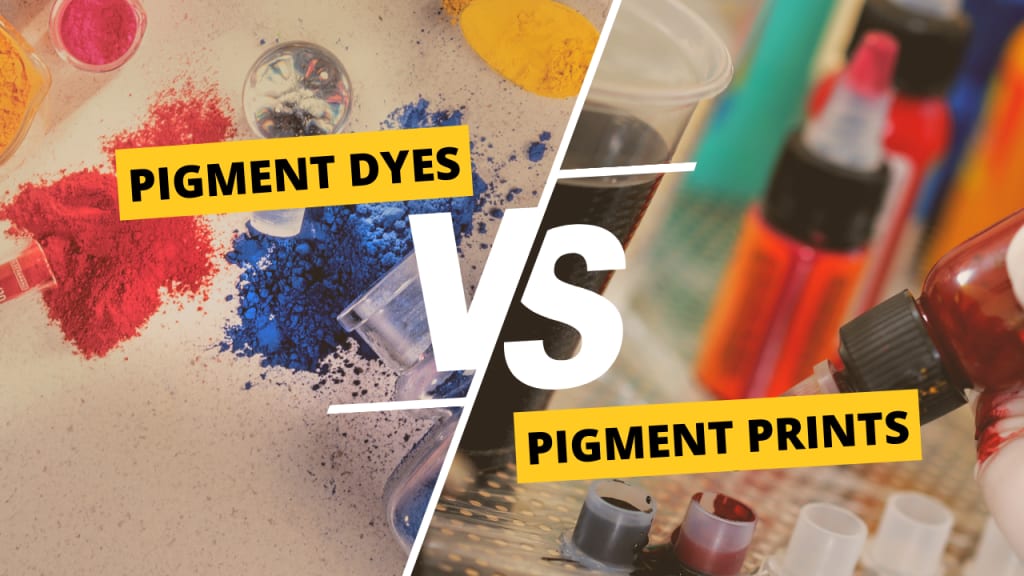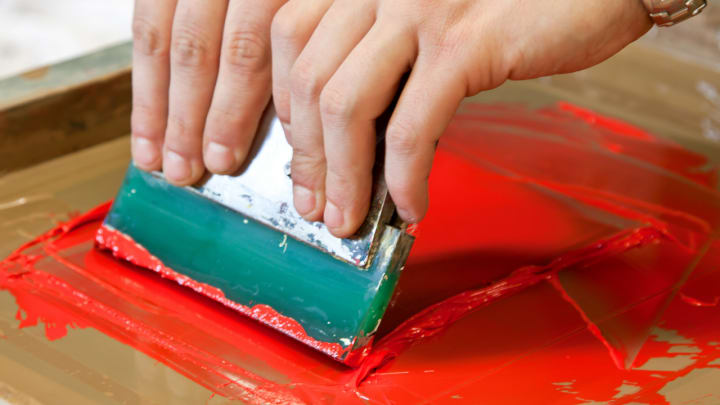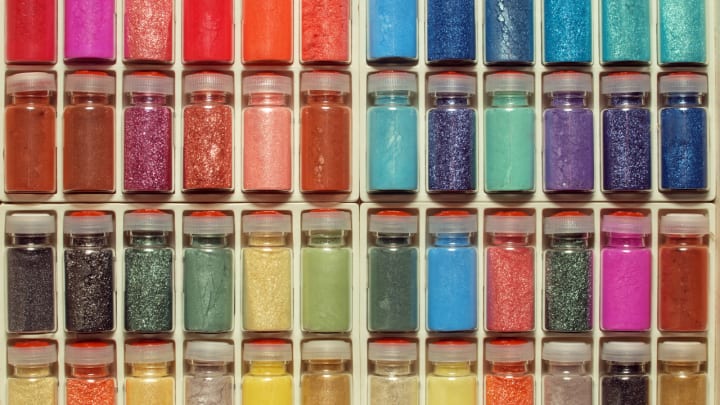Toxic Fast Fashion Secret: Pigment Dyes and Pigment Prints
Pigment Dyes Vs. Pigment Prints

Did you know that a common print and dye process could be a crucial signal that your apparel was made in less ethical and sustainable conditions? And it may even be putting your health at danger... Color crocking is a tell-tale symptom that you need to be on the watch for if you didn't already.
What Is Pigment Ink, and What Makes It Different?
Let's begin by defining pigments first. Something that imparts colour is known as a pigment.
In Garment printing, there are two basic types of inks. Dye is the first step in the process. The color is absorbed into the fibers via a chemical reaction with dye ink.
Colorless pigment ink is available as an alternative to the previously mentioned ink types. Chemical resins or binders hold pigment ink in place while the colour lays on top of the fabric. Basically, resins and binding agents are glue. There are also higher molecular sizes for pigments in pigment dyes, which is why pigment dyes are more expensive than dyes.
Due to the resin binder, pigment prints have a more rigid handfeel than dye prints. When it comes to pigments in general, the darker and more saturated the hue, the stiffer it is.
WHAT IS A PIGMENT PRINT?

To create pigment prints, you'll need pigment-based inks. One of the most frequent and least expensive textile prints, they are also one of the most widely used.
It's possible to print directly with pigments, for example. This type of print, also known as an application print, involves printing directly onto a fabric.
PRINT OR DYE?
The first option is to print each color on a white piece of fabric. This would be the most cost-effective method of production.
Alternatively, the fabric might be dyed green first and then printed with simply the black and brown parts. Because pigment prints are harder than dyes, this would make the green areas of the fabric softener.
But how can you identify the difference if you've never seen a print or know nothing about how it's made?
PRO-TIP...
When in doubt about whether a cloth is printed or dyed, have a look at the reverse side. When dyeing a fabric, the color is applied to both the front and back of the fabric. When the same fabric is printed, only the color will display on the front. It's as simple as that.
PIGMENT DYEING
WHAT IS A PIGMENT DYE?

Similar to printing pigment ink, pigment dye is a dye made from a pigment. The only difference is that the colour is applied to the entire piece of fabric, rather than just a portion of a print. Stiff pigment dyes on a whole piece of fabric? You might be asking yourself that. There are a few factors at play here.
BENEFITS OF PIGMENT DYE
Why is fashion still using pigment prints if they are so stiff? The simple truth is that fashion is all about maximizing profits while minimizing expenditures.
QUICK AND EASY APPLICATION
Due to pigment dyes' ability to sit on the surface of fibers and fabrics, the amount of chemistry required is nearly eliminated.
Examples include acid dyes, which work with synthetic fibers like nylon, and direct dyes, which work with natural fibers. Direct dyeing nylon will result in a muddy mess. Fabrics made from a blend are made more difficult by the fact that different dyes are required for different types of fibers.
Say we have a nylon/cotton blend shirt that we want to colour. A marble effect will be created if we use only direct dyes to colour the nylon. So we'll need to use an acid dye to recolor the fabric. In cross-dying, two different dyes are used to achieve the same colour on a piece of fabric.
However, getting the same shade of red on both fibres can be a challenge. Double dying, on the other hand, weakens the fibres, resulting in a weaker fabric as a whole.
As a general rule, the entire process is extremely time-consuming, and there is a lot of wasted material as a result of experimenting with different dye submission ink formulas.
Pigments come into play here. A wide variety of fibres can be dyed uniformly by using these products because they sit atop the fabric rather than reacting with it in any way.
Color Matching
When it comes to saving time, pigment dyes are the most straightforward to match up. There is less fabric waste when pigment dyes are used because the fabric will be consistent from lot to lot.
NEONS ON NATURAL FIBERS
Coachella, home of the rapanent pigment-colored clothing
Bold, bright, floro, and neon colours appear to be here to stay, at least for the foreseeable future. I guess festival culture has something to do with it. However, consumers are increasingly requesting clothing made from natural fibres rather than polyester and rayon. The problem with the trend of bright colours and natural fabrics is that they don't mix well. Most ultra-bright colours cannot be achieved with direct or reactive dyes.
However, festival-goers can get the bright colours they desire by using pigments that sit on top of the cotton and simply coat it.
In addition, the majority of festival-goers are looking for low-cost options. Wear them once, take a few Instagram photos, and then toss them in the trash! Pigment prints have the added benefit of keeping costs and prices low.
Last but not least, pigment dyes have a high degree of colour stability. To put it another way, this means that they will not fade in the sun or other natural elements.
Less Water Usage
Pigment dyes don't use as much water as dyes do, so they're more environmentally friendly. Because pigments are insoluble, pigment dye does not need water (they can not dissolve in water, they just float around in it). A paste, rather than a solution, is required for pigment dyes to penetrate the fabric.
Disadvantages for Pigment Dye
The use of pigments rather than dyes has some advantages. Inks and pigment dyes, on the other hand, aren't perfect. They're having some major problems with their performance.
Although pigment dyes save water, they still require a lot of heat.Heating is required after the dye has been pressed in. Temperatures of up to 400 degrees Fahrenheit are reached during the curing process.
This happens every time a pigment print is washed. The vibrancy of a garment's color diminishes after about 20 washes. It's fast fashion, so pigment dyed clothing won't last forever.
STIFFNESS
The stiffness of the fabric has come up before. However, I'll bring it up again.
DYE CROCKING
Pigment dyes have a tendency to crock because they sit on top of the fabric. Crocking is the act of a colour being transferred to another object. Dark colours and reds are the most prone to cracking.
It can be difficult to keep your shirt in place when it's printed in black on white. If the black crocks or transfers onto the white, the shirt will have black stains. Due to the fact that it occurs when the fabric is dry, the process is known as "dry crocking."
But, in some cases, crushing can be good.
Did you know indigo is a pigment dye? When indigo yarns are dyed, a coat of indigo pigments wraps around the outside of the yarn. Indigo dying is similar to candle dipping (another camp activity). The yarn dips between 3 and 9 times. Each time, a new layer of indigo wraps around the yarn, and the colour gets darker with each dip.
And this special dye and this process are what give indigo all of its characteristics. As the layers of blue wear away, designs like whiskers and different shades of blue start to show up at the knees. This can be done by hand sanding in the factory or just by time.
The process of crocking, or losing colour, is especially obvious in raw denim. After crocking, raw denim goes from almost black to the colour of a pair of custom jeans, which is a lot lighter. You can tell which parts of the garment have high abrasion (or a lot of mechanical action/rubbing) because those are the ones that wear out first. The cool thing about raw denim is that your pair is unique to how your body moves, and the indigo wears off.
LOWER QUALITY FABRICS
Remember how pigment prints and dyes make fabric stiffener? Nice fabrics are useless if pigments cover them up. Therefore, pigment dye fabrics are the cheapest. The fibers are short, the yarns are inconsistent, and the fabric is sometimes damaged. Pigments will cover everything up.
MASS PRODUCTION
It's impossible to see anything without being covered in pigments. The more we know something is going to sell well, the more we make of it. This is a common practice in fashion.
Using the t-shirt example, we already know that they're a popular item each year. That being said, the most popular shade tends to shift from season to season. Garment dyeing is used by the industry to get the financial benefits of mass production without having to commit to colors.
Using garment dying, an entire garment can be coloured in a factory setting. The dyes used may not react with the shirt's sewing threads or other components during the dyeing process, resulting in a different color. You can get the same shade of the same pigment throughout the entire garment, and it will all match perfectly.
LACK OF TRANSPARENCY
Pigments, in contrast to other types of dyes, are universally compatible and don't have a particular animosity toward any particular type of fibre.
As a result, dye houses do not need to know what they're dyeing, nor do they need to conduct any sort of fabric testing. They can simply apply the pigments to any fabric that walks through their doors.
Creating custom dye formulas and testing fabrics for content are both time-consuming and expensive. In the world of fast fashion, efficiency is everything. And the more money a company can make, the quicker it can get something done. When it comes to pigments, it's clear that expediency in manufacturing was a top priority.
PIGMENTS CAN BE DANGEROUS
The printing and dyeing of pigment is therefore extremely difficult. Textile chemists devised a solution to soften the fibers. Phthalates should be included as well. There are chemicals in phthalates that work to soften the pigments and make the material more comfortable.
What do you think?
Actually, no.
Phthalates cause liver, kidney, lung, and reproductive damage. There is no doubt that they are dangerous, so they are banned from all children's clothing. Kids' clothes have to meet the strictest safety rules. And the American Association of Textile Colorists and Chemists has a strict set of rules about how to test for and find phthalates. There are some inks that are made without phthalates, but they are rare and tend to be more expensive.
If you are worried about phthalates right now, watch out for them in your shoes and any other rubbers and plastics you buy... I'm thinking I should write a post soon about hidden toxins in textiles...
About the Creator
Enjoyed the story? Support the Creator.
Subscribe for free to receive all their stories in your feed. You could also pledge your support or give them a one-off tip, letting them know you appreciate their work.





Comments
There are no comments for this story
Be the first to respond and start the conversation.